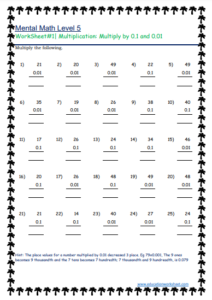Quick Multiplication With 0.01
Quick Multiplication With 0.01
Quick Multiplication With 0.01 is a simple operation that can be done quickly and efficiently. This operation essentially involves moving the decimal point two places to the left or dividing the number by 100. Here’s a brief description and an example:
Description: Quick Multiplication With 0.01 is equivalent to finding 1% of that number. It’s a straightforward process that can be performed mentally or with a calculator, making it useful for calculating percentages or converting between percentages and decimal numbers.
For Example

Example: Let’s say you want to find 0.01 times 375. To do this, you can:
- Mental Calculation: Move the decimal point two places to the left.375 * 0.01 = 3.75So, 0.01 times 375 is equal to 3.75.
- Calculator: Enter the number and multiply by 0.01.375 * 0.01 = 3.75Again, you get the result of 3.75.
This method is handy for calculating percentages, such as when determining sales tax or discounts, and it simplifies the process by converting percentages to decimal form or vice versa.
How to do quick multiplication with decimals?
Quick Multiplication With 0.01 Multiplying decimals might seem daunting at first, but with the right techniques, you can perform Quick Multiplication With 0.01 and accurate decimal multiplications effortlessly. In this guide, we will break down the process into simple steps and provide examples to help you understand and master this essential skill.
Step 1: Align the Decimals When multiplying decimals, Quick Multiplication With 0.01 the first step is to align the numbers properly. Place the decimal point in the result by counting the total decimal places in the numbers being multiplied. If there are no decimals in the numbers, consider them to be at the end.
I will jump in before people talk about “moving the decimal point”. Notice where the 1 is in relation to the units position. In the first instance it is one place to the right. That means that when you multiply by it, every digit in the multiplicand also moves one place to the right. You may lose trailing zeroes, or introduce a decimal point, or even introduce leading zeroes, as a result. Thus:
Example
1970 x 0.1 = 197
197 x 0.1 = 19.7
19.7 x 0.1 = 1.97
and even
0.197 x 0.1 = 0.0197
Similarly if you multiply by 0.01, but this time, the 1 is two places to the right of the units place, so every digit in the multiplicand also moves two places to the right.
Example 1: Multiply 3.25 by 1.5
3.25
× 1.5
Step 2: Ignore the Decimals For now, ignore the decimals and treat the numbers as if they were whole numbers. Perform the multiplication just like you would with whole numbers.
Example 1 (continued): Multiply 325 by 15 (ignoring decimals).
325
× 15
_______
Step 3: Perform the Multiplication Multiply the numbers as you would normally, starting with the rightmost digit. Remember to carry over any carry values as you go to the left.
Example 1 (continued): Multiply 325 by 15.
325
× 15
_______
325 (325 multiplied by 5)
650 (325 multiplied by 1, shifted one position to the left)
_______
4875
Step 4: Place the Decimal Now, consider the total number of decimal places from the original numbers (in this case, there are two decimal places combined). Place the decimal point in the result so that it has the same number of decimal places.
Example 1 (continued): Place the decimal point.
3.25
× 1.5
_______
4.875
Step 5: Final Result The final result is 4.875.
Example 1 (continued): The product of 3.25 and 1.5 is 4.875.
Conclusion: Multiplying decimals quickly becomes second nature with practice. By aligning decimals, performing the multiplication as if they were whole numbers, and correctly placing the decimal point in the result, you can confidently and accurately multiply decimals.
Why is Quick Multiplication With 0.01 the same as dividing by 100?
In this activity, we will practice dividing by 0.1 and 0.01
Quick Multiplication With 0.01 is the same as multiplying by 10. This is because there are 10 tenths in a whole.
Dividing by 0.01 is the same as multiplying by 100. This is because 0.01 is one hundredth and there are a hundred hundredths in a whole.
Examples

19.21 ÷ 0.1 = 19.21 × 10 = 192.1
7,190 ÷ 0.01 = 7,190 × 100 = 719,000
Notice that numbers get bigger when you divide them by 0.1 or 0.01


